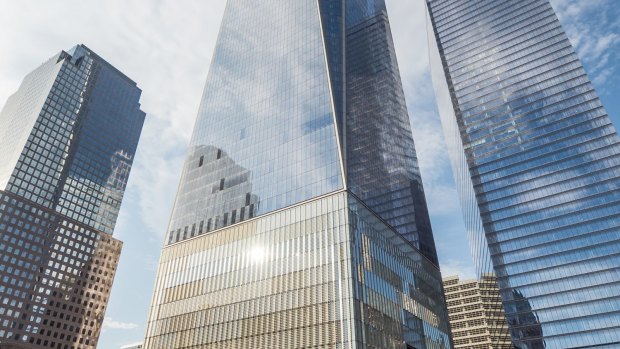By Lee Tulloch

One World Trade Center and Freedom Tower.Credit: Getty Images
Fifteen years ago this weekend I was sitting at my desk in my loft a few blocks north of New York's World Trade Center when I heard an almighty engine roar above my head and looked up to see a plane smash full throttle into one of the twin towers.
That first image - the cookie cutter impression the plane left as it entered the building, white paper and debris raining down like glitter - wasn't captured front-on by cameras, but it's seared in my brain forever.
How could I forget it? My neighbours poured into the street, confused. The cops were dazed, frozen. Groups of people massed on the side streets, running away from the towers, screaming.
Survival instinct made me leave our building before the south tower fell - I was half-way up to Fourteenth Street when I saw the debris billow up West Broadway. It was only when I reached a friend's safe haven in Chelsea that I knew the tower had collapsed.
After 15 years, the turmoil set in motion by those attacks and the military and political reaction to those attacks forms a tragedy still being played out in many parts of the world. But New York bounced back, more expensive and exclusive than ever. There's a shiny new Freedom Tower, magnificent reflective pools in the footprints of the two towers, and an astonishing new transport hub, the $US4billion Oculus, with its ribs of steel like an open pair of wings, making the site a compelling destination for tourists.
For me, the shock of the event and the heartbreak associated with it has worn off. The human heart is an amazing thing; it can heal itself if it is given time.
But mine still has a tender spot, which is why in trips to New York recently, I've been ambivalent about visiting the 9/11 museum that has been built in the bowels of the buildings.
Friends who shared my 9/11 experience call the reflective pools, which are such an emotional touchpoint for tourists, the 'drains of doom.' That gives you an idea of how raw the experience still is.
A couple of months ago, in New York for a few days, I finally gathered up enough courage to visit the museum. To be truthful, I was seeking a reaction, as I'd buried so much these past years.
The museum tells the story of the events of 9/11 through more than 11,000 artefacts, 40,000 images and oral histories told by families of victims, volunteers and survivors.
As you descend into the building, there are various galleries and, finally, the historic museum. The first galleries, which exhibit salvaged parts of the buildings, are quite majestic, if you can detach their content from the spectacular space. Objectively, the twisted lengths of steel and the smashed vehicles are as beautiful as an exhibition of the works of the great sculptors Richard Serra and John Chamberlain.
The slurry walls, which held back the Hudson River, have been left as they were, stripped and rough. It did feel very much like going into a tomb. I thought of the unknown man in the newsstand that once existed there, who illegally sold cigarettes to my 13 year-old daughter and her friends. Where is he now?
The museum itself contains a wealth of memorabilia for history buffs, such as a display featuring the terrorists and their backgrounds. I didn't much care for that, thinking it inadvertently made icons of them, and I also didn't care much for the sheer number of artefacts collected, room after room of them, including an entire shopfront covered in debris. I thought it made a fetish of it all and I was looking for the exit doors sooner than I expected.
I have my own memorabilia - a check that floated down from the towers onto my window box, the dress I wore on the day, a video I took of the second plane hitting. They're in a box somewhere.
I understand it's important for people to acknowledge the human cost of 9/11 and grieve. Those who directly lost their lives in New York and Washington D.C. are mourned generously here. It's a poignant place, even if I have misgivings about it.
My personal reflection is about the aftermath, which is ongoing, in refugee camps and destroyed cities elsewhere. On other shores, hundreds of thousands of people died and many are still dying from 9/11's consequences.
How will we mourn them?
Sign up for the Traveller Deals newsletter
Get exclusive travel deals delivered straight to your inbox. Sign up now.